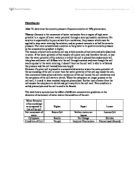In this laboratory activity I will investigate the processes of osmosis in a model of a semi-permeable membrane system. I will also investigate the effect of solute concentration on percent change in mass as it relates to living plant tissues.
B. Hypothesis
If the percent change in mass of carrot cells is related to solute (sucrose) concentration then as the concentration of solute (sucrose) is increased, the mass of the carrot will decrease thus demonstrating an inversely proportional relationship.
C. Variables –
1. Independent Variable- Solute (sucrose) concentration.
2. Dependent Variable-- Percent change in mass of carrot
3. Controlled Variables- Time immersed in sucrose-water solution, amount of solution in each of the six beakers, room temperature, general size of carrot slices with some measure of uncertainty
D. Method (Procedure)-
1. Materials
Solutions: 15-25 ml of each of the following:
*Distilled Water
*0.2 M sucrose
*0.4 M sucrose
*0.6 M sucrose
*0.8 M sucrose
*1.0 M sucrose
Balance
Sharpie pen
Masking tape for labeling
(6) 50 mL beakers
25 mL graduated cylinder
Carrots
Single edged razor or knife
Paper towels
Clock or watch
2. Procedure
1) Pre-mix 6 beakers of sucrose solutions in water.
1. Calculate the mass of sucrose necessary to make 25 ml of a solution of 1.0 M sucrose:
Necessary info:
a. Molar mass of sucrose: 342.3 g/mol
b. You want to make 25 ml of solution.
c. M = moles/Liter
Sample Calculation:
a. 1.0 mol/L (1L/1000ml) = 0.001 mol/ml (This step converts from moles/liter to moles/ milliliter)
b. 0.001 mol/ml (25 ml) = 0.025 mol (This step allows you to find how many moles of sucrose you need)
c. 0.025 mol (342.3 g/mol) = 8.56 g sucrose (This step converts the number of moles to grams that you can mass.)
Add your sucrose to a graduated cylinder
Add distilled water to the graduated cylinder until the total volume is 25 ml.
Pour your solution into a labeled beaker and allow the sucrose to fully dissolve.
Repeat this procedure to make the rest of your solutions (0.8 M, 0.6 M, 0.4 M, 0.2 M)
2) Label your six cups Dist. H2O, 0.2M Sucrose, 0.4 M Sucrose, 0.6M Sucrose, 0.8M Sucrose, and 1.0M Sucrose with masking tape and a pen.
2) Using a single-edged razor or knife, carefully cut six carrot slices that are the same thickness (approximately 5 mm in width) and blot them dry on a paper towel if any moisture is present.
3) Mass (weigh) each to the nearest 0.1 grams, keeping them separate, and record as initial mass.
4) Leave one of the carrot slices in each of the sucrose solutions for at least 15 minutes so that they may gain (or lose) water by osmosis. (Keep them all in the sucrose water the same amount of time-leaving them overnight is likely to give the best results).
6) Remove the slices, blot them dry on a paper towel, carefully re-weigh them and record in the data table as final mass.
7) Remove the carrot slices from each cup. Be careful not to mix them up.
Maybe mass one cup at a time to avoid switching carrot slice with
appropriate solution.
8) Determine the final mass and record in Data Table: Osmosis Results
9) Calculate the percent change using the % change equation described in the section entitled Method: Sufficient and Relevant Data Collection.
3. Method: Controlling Variable
The dependent variable, percent of change in mass of carrot slice, will be controlled by initially slicing the carrots into relatively similar sizes; if not, the initial mass of the carrots will still be recorded to ensure that I know the original mass of each carrot despite whether or not I sliced them the same size. Furthermore, I will immerse the carrots in the solution for the same amount of time. In addition, I will use the same amount of solution for each of the six carrots. Also, I will dry the carrots before and after immersion to ensure there is no extra weight factored into my calculations. Finally, I will weigh the carrots after immersion to calculate a final mass to utilize in my calculation of percent change in mass.







